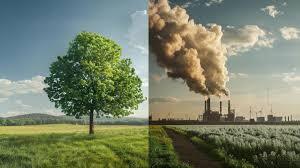Dorsten vs Fresno Pollution Comparison Chart: A Detailed Analysis

In this article, we will dive into a Dorsten vs Fresno Pollution Comparison Chart that analyzes the main pollutants, their sources, and the measures taken by each city to address pollution When comparing pollution levels between cities across the globe, Dorsten, Germany, and Fresno, California, offer an interesting case study. Both cities represent different continents, cultures, and industries, yet face common environmental challenges due to pollution. Understanding how pollution levels in these two cities stack up can offer insights into global pollution trends and the different approaches cities take to mitigate environmental damage.
. By examining air quality, water pollution, waste management, and environmental policies, we can better understand how these cities fare in terms of sustainability and public health.
Understanding the Basics of Pollution
Before delving into the specifics of Dorsten vs Fresno Pollution Comparison Chart, it’s important to understand the different types of pollution that affect cities. The primary types of pollution include:
- Air Pollution: Refers to harmful substances in the atmosphere such as particulate matter (PM2.5, PM10), nitrogen oxides (NOx), sulfur dioxide (SO2), carbon monoxide (CO), and volatile organic compounds (VOCs).
- Water Pollution: Involves contamination of water bodies due to industrial waste, agricultural runoff, sewage, and chemicals.
- Soil Pollution: Occurs when hazardous chemicals, pesticides, or heavy metals infiltrate the ground, affecting agriculture and ecosystems.
- Noise Pollution: High levels of sound from traffic, industry, and urban life, which can cause health issues like stress, hearing loss, and sleep disturbances.
Now, let’s compare Dorsten and Fresno across these pollution categories.
Air Quality Comparison
Dorsten’s Air Quality
Dorsten is a small town in the North Rhine-Westphalia region of Germany, with a population of around 75,000 people. The air quality in Dorsten is relatively good compared to larger cities in Germany, partly due to its smaller size and less industrial activity. However, it still faces air quality challenges mainly from vehicle emissions, nearby industrial zones, and coal-fired power plants that contribute to particulate matter (PM) and nitrogen oxides (NOx).
- Particulate Matter (PM2.5): The PM2.5 levels in Dorsten average around 10-15 µg/m³, which is below the World Health Organization (WHO) recommended levels of 25 µg/m³. However, during colder months when coal-based heating increases, these levels can spike.
- NOx Levels: Nitrogen oxide levels in Dorsten are higher due to traffic, particularly diesel vehicles, but the city’s relatively small size limits these pollutants compared to more urbanized areas.
- Ozone (O3): Ozone levels in Dorsten fluctuate depending on the time of year, with occasional spikes in the summer due to vehicular emissions reacting under sunlight.
Fresno’s Air Quality
Fresno, located in California’s Central Valley, experiences far more serious air pollution challenges. With a population of over 500,000, Fresno is highly industrialized and surrounded by extensive agriculture, contributing to significant air quality issues. The city has one of the highest levels of PM2.5 pollution in the United States, mainly due to vehicle emissions, wildfires, agricultural activity, and industrial emissions.
- Particulate Matter (PM2.5): Fresno’s PM2.5 levels often exceed 30-40 µg/m³, which is well above the WHO recommended limits. In times of wildfires, air quality can worsen dramatically, sometimes reaching hazardous levels above 150 µg/m³.
- NOx Levels: Nitrogen oxide levels in Fresno are also significantly high, primarily due to heavy vehicular traffic, industrial activity, and agriculture-related emissions. Diesel trucks transporting goods across California contribute to the high NOx levels.
- Ozone (O3): Fresno often faces severe ozone pollution, especially during the summer. Ozone levels can exceed the national air quality standards, posing a significant public health risk to residents, particularly those with respiratory conditions like asthma.
Comparison Summary
In terms of air quality, Dorsten generally fares much better than Fresno. Dorsten’s lower population density, fewer industrial activities, and its proactive environmental policies contribute to its cleaner air. In contrast, Fresno struggles with high levels of particulate matter and ozone pollution due to its location, size, and economic activities. The Dorsten vs Fresno Pollution Comparison Chart would show a clear disparity in air pollution levels, with Fresno being significantly more polluted in this category.
Water Pollution Comparison
Dorsten’s Water Quality
Water pollution in Dorsten is not a major issue, largely due to strict European Union regulations on water quality. The town benefits from well-maintained water treatment facilities that ensure clean drinking water for its residents. Industrial activities in the surrounding regions are also regulated to prevent harmful chemicals from contaminating water sources.
- Sources of Pollution: Occasional agricultural runoff from nearby farms can contribute to nutrient pollution (eutrophication) in local water bodies, but this is generally well managed.
- Drinking Water Quality: Dorsten’s drinking water meets EU standards, with minimal contamination by chemicals or heavy metals.
Fresno’s Water Quality
Water pollution in Fresno presents more of a challenge due to the region’s extensive agricultural activities. The Central Valley is known for its use of pesticides and fertilizers, which often seep into local water sources, leading to nitrate contamination. Fresno also faces issues with industrial waste and urban runoff affecting water quality.
- Sources of Pollution: Agricultural runoff is the primary cause of water pollution in Fresno, especially in terms of nitrate contamination, which can have serious health effects.
- Drinking Water Quality: Fresno’s drinking water, although treated, has occasionally faced challenges with contamination. Nitrate levels have been a concern, especially for rural areas dependent on groundwater.
Comparison Summary
When comparing water pollution, Dorsten performs better than Fresno, largely due to stricter regulations and better management of water resources. Fresno, while having the infrastructure to treat water, faces greater challenges from its agricultural activities and groundwater contamination, which would be reflected in the Dorsten vs Fresno Pollution Comparison Chart.
Waste Management and Soil Pollution
Dorsten’s Waste Management
Dorsten’s waste management system is highly organized, with a strong focus on recycling and reducing waste. Germany is known for its commitment to waste separation and recycling programs, and Dorsten follows suit. The town has specific collection systems for different types of waste, including organic, recyclable, and residual waste. Incineration plants and landfills are regulated to minimize soil and air pollution.
- Soil Pollution: Minimal soil pollution is reported in Dorsten, as strict regulations govern the use of pesticides and other chemicals.
Fresno’s Waste Management
Fresno, while improving its waste management systems, still struggles with waste disposal challenges. The city has faced issues related to illegal dumping and inadequate recycling infrastructure. While there are efforts to improve recycling rates, Fresno lags behind more environmentally progressive cities in California.
- Soil Pollution: Agricultural activities have contributed to soil pollution in Fresno, particularly due to the heavy use of pesticides and fertilizers. This can affect local ecosystems and food production.
Comparison Summary
In terms of waste management and soil pollution, Dorsten is again the leader compared to Fresno. Germany’s strong environmental policies and well-organized waste management systems give Dorsten an edge over Fresno, where agricultural and urban waste issues persist.
Noise Pollution Comparison
Dorsten’s Noise Pollution Levels
Noise pollution is minimal in Dorsten due to its small size and quieter lifestyle. While traffic and industrial activity do contribute to noise, it is not considered a significant public health issue. Regulations are in place to limit noise from factories and residential areas, particularly at night.
Fresno’s Noise Pollution Levels
Fresno, being a larger and more industrialized city, faces higher levels of noise pollution. The heavy traffic, particularly from freight trucks and agricultural machinery, contributes to elevated noise levels. Urban development and population density also add to the noise pollution challenges.
Comparison Summary
When it comes to noise pollution, Dorsten has significantly lower levels compared to Fresno. Fresno’s status as an agricultural and industrial hub makes it noisier, which could lead to stress and other health concerns for residents.
Conclusion
In this Dorsten vs Fresno Pollution Comparison Chart, it is clear that Dorsten generally experiences lower levels of pollution across multiple categories compared to Fresno. Dorsten benefits from Germany’s stringent environmental regulations and its smaller population, which contribute to better air and water quality, less soil pollution, and quieter surroundings. Fresno, on the other hand, faces greater pollution challenges due to its larger population, industrial activity, and agricultural practices. Addressing these issues will require continued investment in clean technologies, stricter regulations, and community awareness.
Both cities, however, can learn from each other’s approaches to pollution control and environmental sustainability. By comparing their pollution levels, we can highlight the importance of proactive environmental management in ensuring a healthier future for all residents.
you may also read fastblogstime.



